Since I came back to Houston in July, I've been very eager to find time to support and contribute back to our great community. I was discussing the same with our Marketing Director and she came up with a great idea: "You will not find free time, how about we help Houstonians with something we are passionate about:- building software. We have a free version of our product, but we charge for onboarding services. why don't we offer onboarding and setup services for free to a number of Houston businesses each month."
Our platform helps small and medium service businesses with an Integrated Software to build a website, manage leads, appointments, eCommerce, and much more. Business owners still need help to set up their website, the pages, upload content and graphics, and get trained to use the software. This comes with service charges from freelancers or a Houston digital marketing agency.
This is a difficult time where COVID19 has impacted so many people; that combined with the fact that a lot are trying to setup their own businesses to make a living, we will be offering our services for free at least one day per week for the next three months. Two team members and I have volunteered to participate. With this time, we can help between 30 and 50 Houston based small service businesses or new business owners to setup online with a modern and responsive website integrated with calendaring and lead management system. We will also train you on using the software to manage your online presence to generate business online.
As part of the program, we will also run free technical workshops on what we learned about effective digital marketing campaigns:- like do's and don'ts with Google Ads, how to build a landing page, how to run an SEO campaign on a budget, etc.
LeadCenter.AI is a cloud-based CRM software for small service businesses to build a website fully integrated with lead management, cloud telephony, calendaring, appointments, eCommerce, chatting, and notification systems. While the various components of our platform are available already in the market, it is expensive and beyond the reach of small service businesses. It can cost up to $10,000 or more to get all those components and related services to integrate them together. With LeadCenter.AI our vision is to make the same software, with the functionality that matters the most for small businesses, available either for free or at price point that doesn't exceed $99 per month inclusive of services.
The free plan includes a Free CRM integrated with a free Website Builder, free hosting, integrated Calendaring and Appointments System, an easy to use integrated Lead Management System, and receiving leads by email and contact forms. The Free plan is suitable for new business owners that wants to advertise about their service business online and get leads and appointments organized from those sources.
We will provide the onboarding and setup services for free for a number of businesses for three months. It will be first come, first served because we will have the capacity to support 30 to 50 businesses each month. We will also run online training to teach you have to use the software to run your business online.
No, you can continue on the Free Plan. It is FREE FOR LIFE. Please check our terms of services for all the terms and conditions that apply to this program.
Yes, you can send any support request to support@leadcenter.ai.
Register for free at app.leadcenter.ai. The first 10 registration each Monday will get into the program and they will have their website ready latest by the following Sunday. You can also send us an email to houston@leadcenter.ai and will enroll you into the program.
A practical example by a startup using YC SUS

We are not a new startup as we launched 4 years ago in the Middle East as a services marketplace. Back in July 2020, I relocated to the United States to launch the business here. However, In the US, we pivoted to a different business model which is an SAAS-based subscription (You can check the footnotes to learn what LeadCenter.ai is about and what we are trying to do. But it doesn’t matter. The methodology applies to any startup).

As we are new to the US market, we were trying to get help from multiple places. I enrolled in YC Startup school around the end of June but was too busy to do anything with it as I was occupied with the relocation and settling down. I visited the website again around August 25th, 2020; I gave the material a quality 2-3 hours review and I was stunned and marveled. This is exactly the help we are looking for and we are getting it for free! We had our fair share of mistakes in the first 4 years, and that made the curriculum and content very relevant. So, we can relate easily to the lessons and our experience. While watching the videos or attending office hours sessions, we realized the value of the information.
However, doing the weekly updates can be a bit tricky at the beginning. Also, making an execution plan can be trickier. So, I am sharing how are we doing it: the execution plan for the first six months and the things we scrapped out based on what we learned in SUS.
So here we go:
Objective: Reach to $100 Million ARR in 7 years
Our primary metric in SUS weekly update is Annual Recurring Revenue (ARR). We selected ARR vs. MRR because in the first 6 months we are focusing on customers that will pay the subscription charge upfront annually. So, when we look at ARR at any point in time, this is the actual cash we collected in our stripe or bank accounts.
Grow ARR at an average of 24% WEEKLY! for the first 6 months
It took just a couple of hours to build a 6-month weekly forecast vs. wasting days or weeks in building a complex full financial forecast (we said we will deal with that later).

You will notice that there are four critical KPI’s missing: Churn rate, LTV, CAC, and Days to Close. I have added a footnote at the end of this article for those. Our North Star is to grow ARR to $76,000 in 6 months by maintaining an average of 24% weekly growth. We did other changes based on what we learned from SUS. For example:
we split the weekly activities load to 60%-40%:
However, we agreed that this week's target is the top priority and we will do
anything to achieve it. If there is time left, we will work on next week.
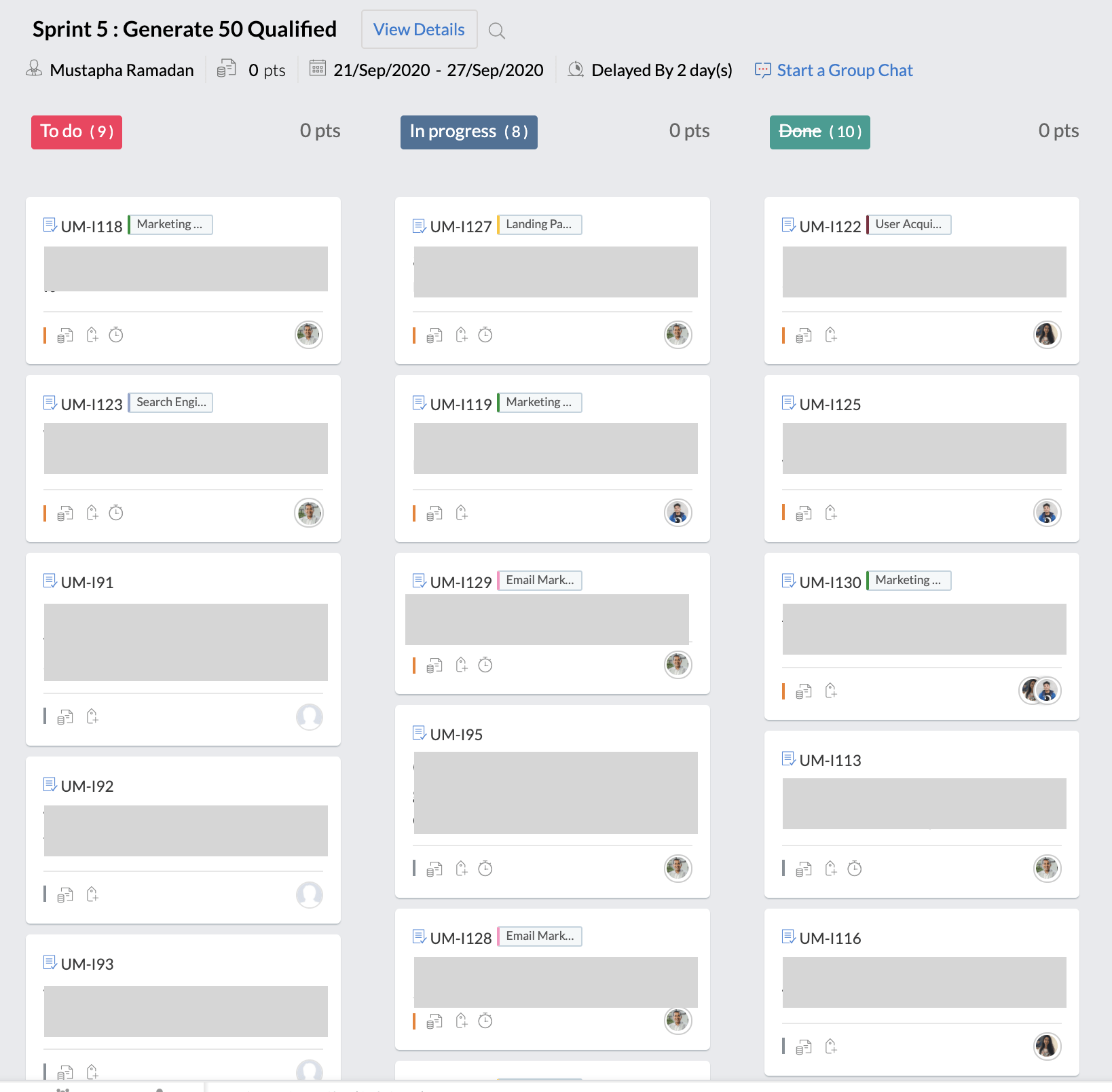
For an SAAS, this is the most critical component to establish early on to measure the conversion at various points. You will need to settle on a CRM to manage your pipeline (you can start with a simple excel sheet). For us, the CRM is integrated into our platform. So, we used our tool.

Again, we are doing things that don’t scale to manage this pipeline; but with time, we will be applying more automation to optimize the conversion process.
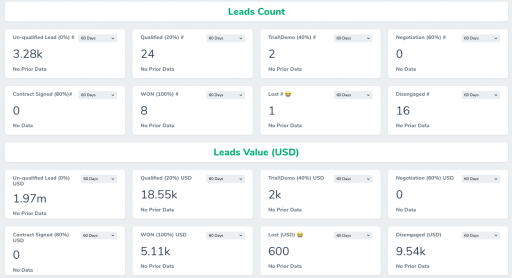
For the last 4 weeks, the entire team got together every Monday morning to do the following
Below is the latest update. We review the pipeline together, then we launch a new weekly sprint and create the tasks for the week to achieve the primary KPI and weekly objectives.
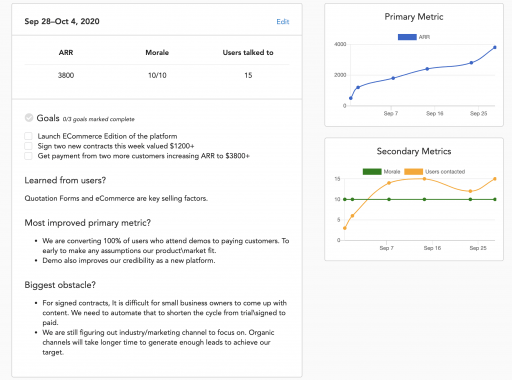
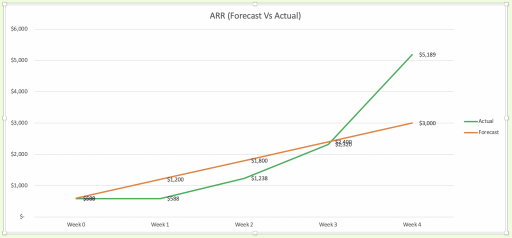
The last four years taught us that 500 things may go wrong: The assumptions we are making now may be wrong at the next scaling point, there may be changes in the market or innovations that may make our platform irrelevant, we may fail to raise funding, etc. However, two things matter the most for survivability:
Perseverance is that you are in it for the long run. Regardless of the pain and failures, you will endure in the first few years. If you are persistent, you will figure it out eventually. Whether it will take 1 month or 1 year.

Fiscally responsible: if you are in business, startup, lifestyle, or a large corporation, it comes down to one simple formula: Z = X - Y. A company is a Profit = Revenue – Cost.
I am not sure if the first can be taught, but you can definitely learn the second. It took us 4 years to figure out how to operate a profitable service marketplace company. Our branch in the Middle East is generating now Multi-Million Dollars in GMV annually. Our revenue reached hundred of thousands of dollars per year, and we are growing at an average of 15% monthly for the last 7 months, so we are on a path to reach the $1 Million Revenue Magic Mark very soon. Frankly, I have no clue how we got there while making every mistake we should've avoided. The only explanation is Perseverance.
Recently, I came across this quote by Noah Kagan. I love it. Not the point about getting rich. Actually, a lot of entrepreneurs don't give a shit about money, rather pursuing their passion and building things. The ones that are doing it for the money can't handle the pain; they quit and get back to jobs with salaries. The point is it takes many many years of hard work with little rewards to build something meaningful.
We are carrying on for the next 7 years. We may fail to reach a $100 Million in Revenue. We may reach it at later date. However, if we are persistent and fiscally responsible, the worst-case scenario could be a lifestyle SAAS business with $8Million to $10Million in revenue, paying the 4 founders as well, and leaving us with marginally good profit.
Good luck to all of you. One last thing: Thank you YC Startup School team. Amazing work! and highly recommended to all new founders.
For more about our journey you can read:
July 2020: The 15 things we did to avoid closing down our startup because of COVID19!
June 2018: The top ten 10 mistakes we did launching an Internet Startup and how we survived so far.
July 2017: My first year anniversary after leaving a secure job at Microsoft to start my own business. What is it like?.
Dec 2016: The 6 things you have to forget when you leave your job to open your own business.
footnotes :
I was working on porting this query today from Storat UAE to US system. It’s 98 lines of code. I wrote it 7 months ago to help automate CAC calculation for our marketplace at the buyers' side. Looking at it now my thought was “Shit, this is complex, I wrote that????”. As I am **officially** a non-technical founder, I decided to write a story about how I became a programmer again. I didn’t write any code since my first job in Microsoft which was more than 20 years ago.
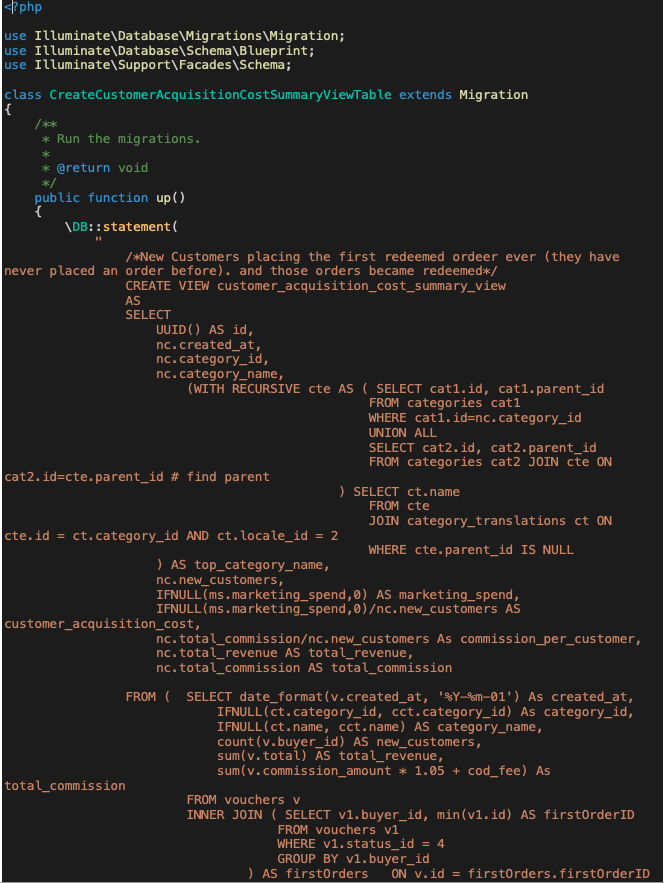
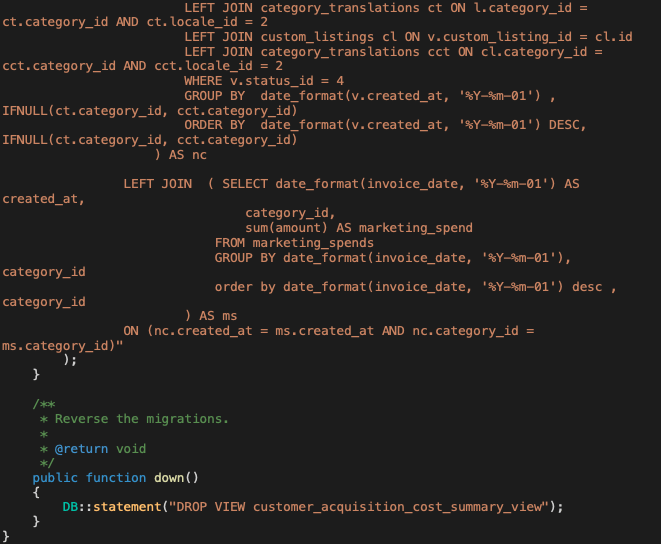
When you are working in B2B2C (like a service marketplace) the algorithm can become complex. It becomes tricky when 60% of buyers opt to call or chat and the order is placed indirectly through the call center. It is not rocket science, but I wanted to come up with an automated way to track CAC, marketing spends, revenue, and profitability. Also, I wanted to determine those factors at top categories and child categories level where we can slice and dice the data easily in excel. Attached also are two frontend systems that are built on those queries so my team in the Middle East can look quickly at those KPIs without wasting time on gathering data again.

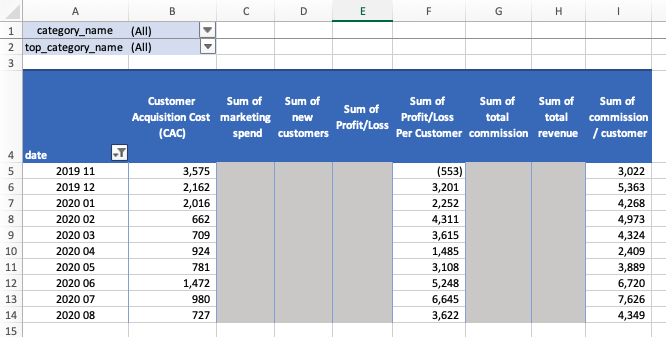
Please sign up at https://app.leadcenter.ai/registe... and tell us what do you think!
Coronavirus, Winston Churchill, and Storat. How did our startup survive while being a services focused startup, so far!
Note: I wrote this article on July 5th ,2020 on a 15 hours empty flight from Abu Dhabi to Chicago as I was relocating to open LeadCenter.AI in United States, which is one of the steps we took so our startup could survive COVID19.
In February 2020, our company started feeling the impact of COVID19 and by March 31st, our daily revenue reached ~ $0 per day. Our startup is an online marketplace in the UAE focused on services with a commission-based business model. The country came under a complete shutdown for services. We stopped receiving bookings for swimming lessons, sports classes, salons, laser hair removal sessions, and home services like cleaning or moving. (figure 1).

In late March 2020, the logical course of action was to shutdown the company and let everybody go. However, we had one advantage, we were nimble and got used to pivots as we were still perfecting the business model.
What happened in the next three months is a story to tell and I am happy to share with other business owners and startup founders as they can benefit from some of the tactics we applied. Not only we survived, but we doubled the company revenue and profit by June 2020 and increased the daily booking from 0 to ~AED 90,000 ($ 25k) per day by early July 2020 (figure 2).

Yes, that is correct; while other companies started reducing marketing spend, we did the exact opposite, we tripled our marketing spend! The rationale was simple:
Coronavirus hit the two main categories that drove the majority of our revenue: cosmetic medical and sports. We switched our focus to home and office services (cleaning, moving, overseas shipping etc.). We also considered launching three new categories: grocery delivery, laundry delivery, and disinfection services. We scrapped grocery delivery because of the logistics complexity. We launched laundry delivery and disinfection services in 48 hours around mid-March 2020. We had relationships with many relevant suppliers. We built the relevant forms on the web and mobile platforms, launched a marketing campaign, and we were in business.
Actually, we were pushed into Business to Business (B2B). Storat was focused on Business to Consumer (B2C) services and it represented 98% of our revenue. Before the coronavirus, we were puzzled on how we would enter B2B while staying nimble and lean. In the middle east, B2B requires a field sales force and more traditional tools to gain market share. The coronavirus changed all of that. We started receiving more and more calls from businesses requesting various services. What happened in the first sixty days was:
we stopped recognizing revenue if it is not yet collected
The difference between accrual and cash basis accounting is the timing of when revenue and expenses are recognized. The cash method is a more immediate recognition of revenue and expenses, while the accrual method focuses on the anticipated revenue and expenses. Why was this important to do under the coronavirus pandemic?
With Coronavirus hitting small and big businesses hard, as predicted, those businesses started facing cash shortages with no quick access to liquidity. The force majeure clause in many contracts meant that collection will be a serious problem very soon. Rightly so, within a few days, some of the service providers started sending us notices asking to delay payments or cancel contracts. So we became more rigid on payment terms even with enterprise businesses.
The prepaid subscription model is one of the reasons we are still in business today
In September 2019, we implemented a prepaid subscription model for home service providers. This may be one of the reasons we are still in business today. What is prepaid model? Before September 2019, our model was postpaid. Meaning, we give orders to service providers through Storat.com. If they deliver the service, we issue a monthly invoice that they have to pay within 15 days of invoicing. It was clear within 6 months that this is not a scalable model as a lot of service providers elected not to pay their invoices! Switching to prepaid model in September gave us a level of control over the marketplace transactions. Hence, we were receiving our commission from service providers before they can accept orders through our platform. It took us six months to perfect the business model, implement the related technology (order distribution systems, billing system for prepaid, etc.), and convince enough merchants with it to create liquidity.
With the coronavirus, we decided to expand the model across all categories. As medical cosmetic centers, sports centers, salons and spas started coming back slowly in early June, we switched all subscriptions to a prepaid model. Our decision was that we either control the transaction in the category or we exit that business! The pandemic made it much easier to make hard decisions.
If you are familiar with marketplaces, the two core metrics for success are Customer Acquisition Cost (CAC) and Long Term Value (LTV). For a marketplace to survive and scale, buyers must keep coming back, ordering through the marketplace so it can cover the CAC through higher LTV for each buyer. The problem with service marketplaces is that buyers and sellers must connect directly for service delivery. Hence, they can exchange contact information and do future transactions directly, cutting out the marketplace. This is a major problem for many service marketplaces, they fail to scale, or switch to lead-based model which can’t exceed 5% to 6% of the Gross Merchandise Volume (GMV) that is going through the marketplace.
In the beginning, we tolerated leakage, as we were more focused on developing the core marketplace technology, onboarding more merchants, and building the required processes (call center, customer service, etc.). With COVID19, we accelerated building the technology and processes to reduce leakage. We developed a new agreement with explicit clauses about future transactions and related penalties. We asked all our merchants to sign them (200 of them!) or they would stop receiving orders through Storat.
As a result, the CAC for home services dropped from AED 102 ($28) per new customer to around AED 50 ($15). The number of repeat orders increased by more than 500% in the same period.

With COVID19, a week became an eternity. We applied two new principles to our development strategy:
Between March 15th and June 15th 2020, we deployed almost every day. Sometimes 2 to 3 per day. Faster deployments meant less testing and more bugs, which made some of our customers unhappy. Also, the pace of changes was too fast for a lot of service providers to learn quickly and cope with. Merchants came back complaining “why are you changing something that is working?” From our end, it was working, but it didn’t scale!
Also, our deployment process was cumbersome, we ran deployments manually using Ansible scripts and it took each deployment between 1-3 hours to complete. COVID19 pushed us to remove all the none essential components from the deployment process. We migrated from Ansible to Laravel envoyer.io. It was also an opportunity to upgrade our back-end systems to the latest versions of Laravel, Php, Nova, Mysql, Linux, etc. and we optimized our infrastructure to run on fewer servers, which gave us extra computing power that we can use for expanding to a new country without incurring additional cost.
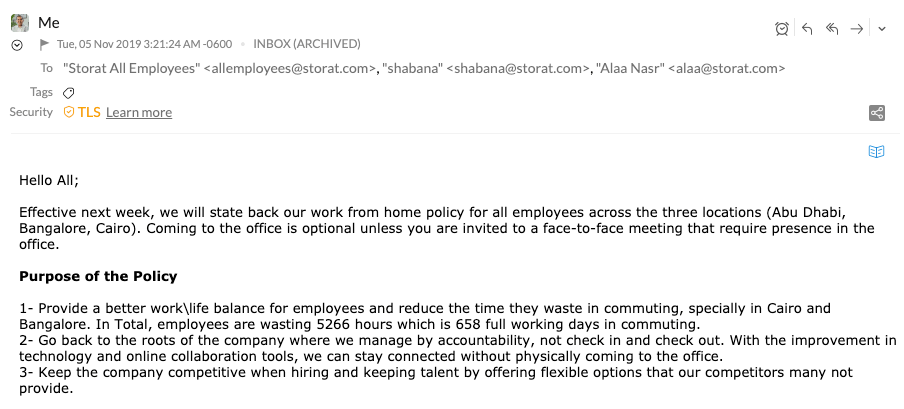
In early November 2019, we implemented a full work from home policy. This gave us a competitive advantage as we didn’t have any operational downtime. While competitors were busy trying to figure out the logistics and operations to run a business remotely, we were set and ready for business. In October 2019, we upgraded the company internal VOIP telephony system from Grandstream to 3CX and we deployed it across the three locations. In the same period, we deployed GSM VOIP technology which gave us a better connectivity with customers while reducing operational cost.
Well this may not be possible for all businesses. But for us, we were 100% cloud-based Internet business. Although we went remote as early as November 2019, we kept our offices in Bangalore, Cairo, and Abu Dhabi as a status of power, to interview new employees, and for internal meetings, if needed. As the coronavirus started spreading in the middle east, we switched to a survivability mode. Those offices became a none-essential liability. We managed to maneuver our company out of three lease agreements in three countries in less than 30 days. That alone saved our company more than $25,000 per month in office rent and other related expenses. It may not be a lot for a big company, but for us, and under coronavirus, this was a large expense.
As a startup with the intent to scale, a large amount of our investment in resources was focused on the long-term objective to scale. For example, we had a subcontracting team working on SEO, merchant onboarding for future categories, etc. We stopped all of that to preserve cash and focus on today’s problem.
Number of positions in our company became redundant or not essential because of the changes we made above. However, it was hard to let good people go, especially if they have developed the expertise in what we are doing and have the motivation to make the company navigate through the pandemic. So instead of terminating people, we moved everybody to sales operations, and I mean everybody! Even HR started taking calls and chats and converting those to orders. We split the sales organization to cover the basic internet web funnel.
We also reduced our marketing channels to two, one for new customers acquisitions and the second for repeat orders. Hence, we needed only one person to cover marketing to generate leads for the marketplace. The rest of the sales team covered bookings, redemption, collection, and after sales customer service.
By mid-May, sales were going well again, we started hiring again in our call center to address the increased demand.
Before coronavirus, We developed extensive business intelligence dashboards to monitor the various aspects of our business. We monitored as many as 100 data points to have a better understanding of key performance indicators and monitor the conversion funnel (figure 5: one of Storat internal BI dashboard).

While it was important, a lot of our employees found it confusing or they couldn’t focus with too many metrics to track. So, we reduced the essential metrics to two and we held everybody accountable for them:
CPM told us how much gross profit we are making after deducting service providers commission. and CAC showed us how much it is costing to acquire new customers. By subtracting CPM from total CAC, we could tell quickly what our gross margin is. As all other cost elements were fixed and all subscriptions were moved to prepaid, the entire company focused in increasing that delta.
Let’s face it, while the UAE is an impressive market, it is a small market. Especially for B2C. The microeconomics for UAE B2C is that there are only 3-4 million people with enough purchasing power to target. With Covid19, that was reduced by at least half. Initially we didn’t plan on expanding to new markets before 2021. If your platform is an eCommerce marketplace, there is much more operational requirements to expand to new markets. eCommerce marketplaces have a skin in the game, we process payments at both ends of the markets, we must meet the regularity requirement of any new country we expand to, and we need direct relationship with banks and local payment gateways.
Our expansion strategy was simple. The next target market was Saudi Arabia and the plan was to open there in early 2021. We would expand there if and only if, we achieved the following three objectives:
Under coronavirus, we have achieved those objectives by end of May 2020. Well, two months of meeting those metrics was not enough time to prove sustainability, but what was happening gave us the urge to take risk and ACT now. All businesses were scrambling to web enable under COVID-19. It was a fulfillment of our vision "Go online or get out of business". So, we made the following changes to our plan.
By mid June 2020, we freezed development in the UAE platform, I handed over the operations in the Middle East. Our small R&D team started working on the US version of the platform. In July 5th, I relocated to Houston and I started setting up the US operations.
The most important aspect of survivability is to keep your team super motivated. In our All Hands monthly company meeting in April 1st ,2020, my team didn’t know what to expect because of the grim results in the previous two weeks and the bad news that was flying all around us. Some people were whispering about their fear of being let go today as this is what happened with their peers in other companies. I started the meeting quoting Winston Churchill 1940 famous quote about the UK policy fighting until the end and never to give up.
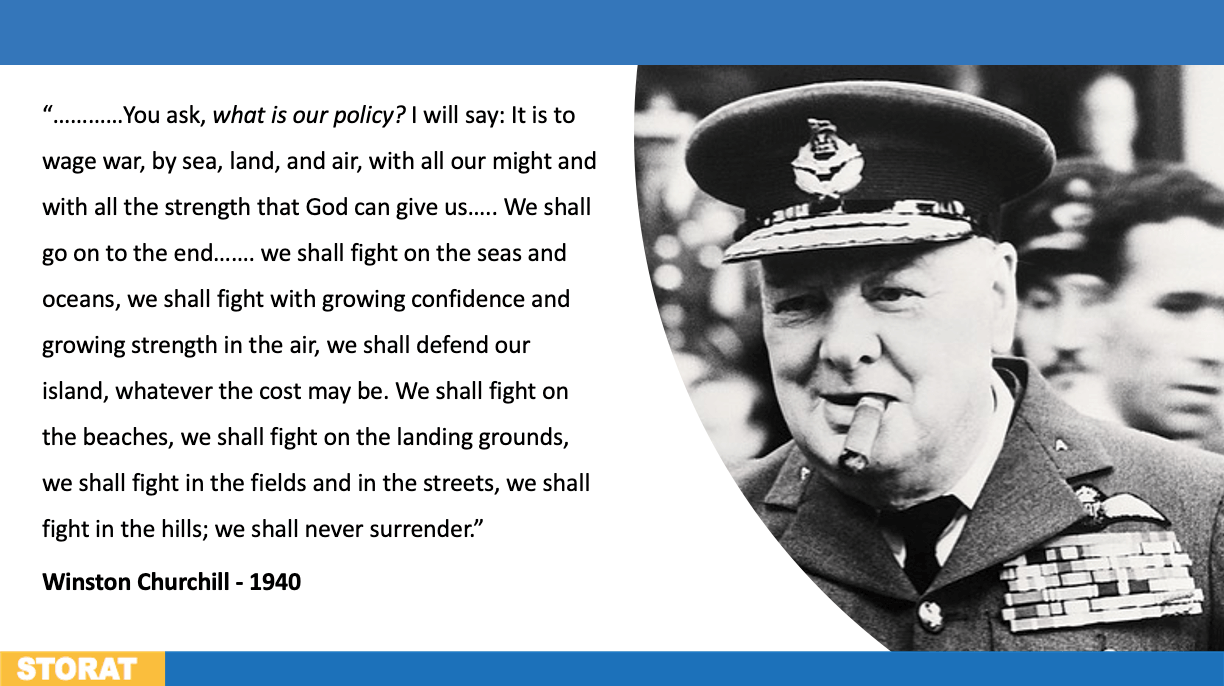
I made sure to read every sentence to them loudly, so it is clear to all that we are not giving up and we are in this fight until the end. Regardless of any strategy, there is nothing in the world like a motivated and determined team. What my team did in the following three months was extraordinary. Ironically, the best three performing months in more than four years in business!
Like many, I am not sure what will happen next, and what is the future impact of this virus on businesses. But even in the grimmest moment, opportunities will always exist;
It is about being nimble, lean, and adaptable to change!
Two weeks ago, I was honored to speak at Glassqube, one of the coolest coworking spaces and startup incubators in Abu Dhabi. The audience consisted of entrepreneurs and working professionals looking to start their own business. My speech was about the top 10 mistakes we did launching an internet startup; The mistakes that almost killed our startup in its infancy. The fireside chat covered topics such as pricing strategy, startup business model, driving traffic & SEO, measuring wrong KPI’s, and selling to customers.
The startup, Storat.com is an online marketplace based in Abu Dhabi, UAE for the past two years. (Storat means shops in Arabic, well its a combo of Arabic and english). We were able to grow the user-base to 60,000 users and over 1,500 paying customers and expanded our back-office operations to two additional countries: India and Egypt. However, we realized that a productplatform company needs many years to find a productmarket fit. We are still in the second year and have a long way to go.
USP (unique selling point): Storat.com offers a unique technology compared to other marketplaces in the middle east (at least that is what we think!). A seller or a business can open a store on storat.com, list all their products and services, and upgrade the profile page to a bilingual website at their own domain in less than 5 minutes, Server-less! Their products and services will be listed on their website, Storat.com marketplace, and connected social media profile pages. The solution has key features to generate and manage leads online including cloud-telephony to capture leads by phone, Lead Management System, integrated chatting, SEO friendly landing and advertisement pages with call to actions to drive leads and inquiries, etc. The entire technology is proprietary and built by Storat development team. (E-commerce integration is coming before the end of 2018).
What I realized, as a founder of a startup, is that my main job is to balance the hundreds of conflicting decisions with extremely limited resources. Mostly, the conflict between scaling a business vs making it survive on its own. A main distinction between building a service-oriented business and a platform/product business is scalability. We focused on scaling fast and we rushed decisions ahead of their time. It took time to realize that scaling fast may accelerate revenue, but it puts us on a dangerously very short runway. We were losing resources much faster than we can recover it with revenue. We were making a lot of mistakes because we were not stopping long enough, analyzing, and thinking things over. Ultimately this could have crashed the startup. We survived so far. Below is our tale from the first two years. We hope this could help other startup founders, specially in the Middle East, avoid those mistakes to increase their chances of success.
The biggest mistake I did before launching Storat.com is not knowing or appreciating the most important asset in the world: time. When planning and building a business, you consider resources like people, money, space, customers, and products! But later you discover that the most precious resource is time. You can’t speed it up, or slow it down.
For example, a lot of startup founders will execute decisions based on saving financial resources, money! Meanwhile, wasting too much time. You may not have the luxury of sufficient funding, if so, doing it yourself could be the only option.
To give a simpler example, in the first year, we were building the platform with no income. It was difficult to spend money. To save, we used free software. We spent hundreds of hours deploying products like ERPNext, Zimbra for email, and others to run our operations and save on spending on commercial software. Now, we scrapped most of the free software and run our back office operations on commercial cloud software. For accounting, we adapted a simple commercial accounting software: Quickbooks! (Get it to your head quickly, you are a small business! Regardless of your scaling plan, use quickbooks instead of a full scale ERP to save time and money!). The time wasted can never be recovered. It could have been used in customer acquisition, core product development, or a more strategic aspect of the business.
A more disastrous example is our early investment in SEO and organic user acquisitions. Again, in the early days it was hard to spend money. So instead of hiring an SEO expert to help us develop a search engine friendly product, we decided we will save the money and figure it out later. It was a huge mistake, leading to the loss of thousands of hours and eventually hundred of thousands of dollars.
Lesson learned: When you can, save time instead of money.
Conflict point: However, it is still a delicate balance between time and money to keep a runway! Your job is to find that delicate balance.
Early on, we realized that our vision would take time to build. Therefore, we decided to accelerate the release of an MVP that resembled a classified marketplace. I hacked the first MVP based on an open source classifieds script in less than 12 hours in August 2015. (Yes, our first MVP took 12 hours to build). We ran a marketing campaign based on that, gathered some user feedback, and then hired a development team to build our real MVP back in April 2016. We launched it in September 2016 as a free classified marketplace were anybody can register and post their products and services for free.
A free/freemium business model may work for you if you have a clear plan on how you will make money. But for us, we didn’t have a plan for that and we discovered few hard realities about free/freemium for a marketplace: While it is important to build liquidity and the network effect, it shouldn’t be at the expense of the marketplace quality. When you make your platform free, you open it up for everybody who wants to trash their stuff for free. Which in turn makes the buyer experience horrible, ruining the reputation of your platform.
If you want to build a trusted marketplace that has liquidity while preserving a great buyer experience, you have to:
Lesson Learned: There is no shortcut to a marketplace liquidity. If you do it at the expense of quality, your platform will just be another trash classified site!!.
Conflict point: if you are bootstrapped like our startup, you will not have the resources to invest in quality and liquidity simultaneously. We are living with the reality now that it will take 4x more time than what we anticipated to build liquidity in the target categories.
In the first 2 - 4 years, you need to live with the reality that your Internet business is not an Internet business. You will have to run it like a traditional business until you build the processes and brand to scale.
When we launched Storat.com, we built landing pages to demonstrate our products and services. We also launched a paid marketing campaign on Google and social media. In the first 2 months, we closed zero deals!! We quickly realized that a startup without a brand will not be able to sell online or even generate leads. So we hired a field sales executive to meet customers directly. Within 3 months we were able to close 80 paying businesses on our platform. Great!!! Not really, check mistake number 4 below about pricing strategy.
Lesson Learned: You have to deal with your internet platform like a traditional business in the beginning.
Conflict point: You may not have the resources to hire sales people, especially qualified ones. You either do it yourself or find another idea that your paying customers are savvy and educated enough to buy friction-less from you. In the Middle East, we realized that there is a large gap between small businesses and the internet. We are winning business from large and formidable competitors because we are on the ground and they are not!!
When we launched the platform, we built our pricing strategy as a friction-less online business at scale!!!! The average price for the product was $300 per year.
we came to know three hard realities:
1- We managed to gather a lot of feedback from paying customers (Our product development is driven by this feedback now). While all the customers validated our vision “somehow!”, we had a gap in understanding middle east small and medium businesses capacity and willingness to invest upfront in building and driving a business online.
2- Small and medium businesses in the middle east don’t want to pay for software, period! They will try to avoid it at any cost. Combine this with a freefreemium model and you will reduce your chances further in monetization. When I worked at Microsoft, it was hard to comprehend the astronomical piracy rates in the middle east (well I worked mainly in the enterprise and I rarely interacted with small businesses!!). Speaking to hundreds of small business owners in the last couple of years I came to learn some of the reasons why. Small businesses are small for a reason. They can’t scale their business for one reason or another. While they can run a successful life style business for many years, majority of them have limited capacity in one area or another. They depend a lot on basic instincts to manage their business. They will not invest in anything that doesn’t have a direct and immediate impact on their bottom-line. They will also not invest in something that is hard for them to understand or use.
3- The sales cycle and on-boarding for a $300 deal is the same as $10,000 deal. So we came to know early that signing up businesses in the Middle East on a SAAS model required field sales. The problem we faced is that a $300 deal took the same amount of time to close as a $10,000 deal. While we were able to close around 80 deals in the first three months, we were going to run out of money in less than 6 months!!!! Each deal required a visit by field sales and an extensive amount of on-boarding. Whatever simple the technology, small businesses found it very hard to write content, describe their services and products, do graphics and videos, or even come up with simple marketing slogan.
However, there was one common feedback among those first 80 customers. I am quoting one of the customer exact words that resonated deeply and became a flagship of our next pivot.
“Mustapha, I will pay you 100 times more than what you are asking if you can bring me business and genuine leads online. And you can do it using your platform, it is a win-win situation.”
And that is exactly what we did. We increased our average price from $300 per year to $15,000 per year!! Then in another three months, we increased it again to $30,000 per year!!!!! The number of offline transactions reduced from 30 per months to 3!!! A lot in the VC and startup community will challenge that as it hinders growth and scalability. However, we kept the online (friction-less) acquisition engine running. Offline, we succeeded in on-boarding 60 paying customers at an average subscription of $12000 per year. Online, we acquired 1,460 paying customers as of May 2018. Online customers pay $27 to start advertising on our platform, then they convert to higher subscriptions if they see more value (up to $3200 per year) or they pay per lead as the platform bring them business.
This approach meant that we are not the fairy tale of a smashing success startup that rose from 0 to hundred of thousands online customers in few months. However, we felt this is the right strategy for our current situation as it gave us the following advantages:
1- We can survive on our own for much longer without external funding. While the number of transactions were low, it contributed to the platform as it was not a side business.
2- It gave us the opportunity to engage paying customers in deeper discussions and feedback loops which resulted in a clearer product roadmap and features development that can be scaled across many industries.
3- In the first few months, we faced few issues related to SEO and technology. Those high value subscriptions gave us a breathing room to work on fixing the platform and technology while keeping the company running.
4- Deeper engagement with customers gave us the opportunity to learn. When we started, we didn’t have any SME’s in critical areas like creative design, SEM, SMM, SEO, and ultimately lead generation. Those few contracts were big enough helping us hire resources and spend quality time in building capacity in those areas.
While we are very supportive of lower transaction value to increase volume and build liquidity, we learned that we need to build a dynamic pricing strategy to support our cash-flow requirement for each stage of the business. We are in the process of dropping our prices now, while increasing the value of the platform to both buyers and sellers.
Lesson Learned: If you are bootstrapped with no VC funding, build a Dynamic Pricing Strategy. Focus on high value transactions in the first few months to self-fund your business, then start lowering prices to increase the volume of transactions. Run your business like a traditional business for the first few months (years!!) while continuing to invest in your strategic goalobjective.
Conflict point: High value transactions are heavily service oriented. You will still need to find the balance to spend more of your time in product design, development, and building a scaling strategy.
We considered the technology we are building a breakthrough! as it helps middle east customers build an online presence very quickly while resolving the problem of driving traffic to that online presence and convert it to businessleads.
In the first few months, our pitch to customers was not perfect!!! We talked about how their website will be cutting edge, the website will be server-less and practically running on hundreds of servers around the world, how we used the latest Algolia search to deliver sub-second search speed for their website. That their website will be using the most modern Content Delivery Networks (Akami) to deliver content quickly to their customers. How we used advanced caching technology in various layers of the platform for performance. How it is SEO friendly out of the box with proper URL, tagging structure, etc to surface quickly in google search. All of that meant nothing to middle east small businesses!!! One customer asked me after I finished the pitch: What is a website??????
So we fixed our pitch, speaking a language that is more suitable for our customer to understand our product and how can they benefit from it.
Lesson Learned: Please save your time and money printing brochures or building landing pages until you speak and successfully sell to hundred of customers. Adjust your pitch and reflect it online.
Conflict point: There is no conflict point, you either speak the customer language or you are out of business.
If you are wondering what is SEO, then you are probably reading the wrong article :). SEO is search engine optimization. It is about your website showing in the first page of search engines (in the middle east google is the one that matters!). When we started building the platform in April 2016, the team had 3 developers and 1 graphic designer. By the time we launched the platform around September 2016, the company had 6 developers and 1 marketing specialist fresh out of college (no prior SEO experience). Although we knew that SEO is an area we have to focus on, we thought we can postpone it until we finish the core development as we were not making any money. The hard reality we faced later is that Onsite SEO is an integral part of website development. If you are building a new platform, there are many trade-offs and technical decisions driven by SEO: the age of the domain you are buying , number of domain hosts, URL structure, tagging structure, design of pages for placing content correctly (above the fold, below the fold, etc), dynamically generated regional URL’s, etc. Everything your platform engine is dynamically generating should be SEO checked before commencing in development. We have made hundreds of mistakes, we spent thousands of hours trying to figure out what is wrong. What added salt to the wound is that many customers turned us down because we are not ranking in google first pages.
The common slogan for our company in 2017 was “what is standing between us and becoming a $100 Million company is SEO!!”
Off course ranking is not enough to build a successful business, but it was an important slogan to mobilize the company around fixing a strategic issue for an internet platform.
 Storat.com organic traffic in the first 2 years
Storat.com organic traffic in the first 2 years
Today, SEO continues to be strategic channel for us to acquire customers and leads. But we know it is not a compensation for building a known brand.
Lesson Learned: Invest early in hiring an SEO specialist before commencing in building an online marketplace.
Conflict point: Hiring an SEO specialist is one of the most difficult hiring exercises. Alot of people will claim being “SEO experts”. But SEO for a marketplace is one of the most complex projects. For example, India has the highest number of SEO specialists in the world. We prepared a list of high value target SEO directors to headhunt. The list contained 50 names! Meaning, in all India, the number of SEO specialists with prior successful experience in marketplaces was only 50!!! At least the ones that we were able to locate!!! So, prepare for a challenging task ahead.

We built our mobile app, after few failures and sizable investment. So, what is wrong with building a mobile app in a Mobile First world?? Well, there is nothing wrong with it if you found your productmarket fit. We did the first trial to build a mobile app only 3 months after launching the platform. The platform was far from mature and we were doing updates and changes everyday. Going web first was the right strategy as we could build features quickly to experiment. However, trying to launch a mobile app very early was a big mistake.
Lesson Learned: postpone building new channels for your products until you find a productmarket fit. A Mobile app should be part of a scaling strategy, not a “me too strategy”. Don’t do our mistake.
Conflict point: The mobile app gave our brand more value in-front of potential customers, helping us close few more deals. However, it is not contributing significantly “yet” to our core KPI’s.
Frankly at the beginning we didn’t know which KPI’s to measure. Or we knew the obvious ones. We were measuring business, financial, and technical KPI’s: number of new user registrations, pageviews, bonus rate, sessions, organic traffic, etc. While those are important, but not the most strategic for a bootstrapped startup. Among the KPI’s we didn't measure in the first few months are:
Lesson learned: A key factor of maturing your platform is building data gathering and analytics tools to measure important Key Performance indicators (KPI’s). Those KPI’s will have critical input for decisions making like which category to focus on, pricing strategy, development of product features, etc.
One of the biggest mistakes we did was scaling too fast in number of areas. an example is that we should have stayed in shared workspaces and business centers for many more months, if not years. We invested in moving to permanent offices in three different countries in less than 16 months. That created a burden on us for managing facilities, spending scarce capital on office furniture and equipment. There is a logical explanation for each decision. For example, in India, it was really hard to attract top talent when you are based in a shared space. With a high number of failing startups in Bangalore , we had to give a sense of stability to new prospects. Renting our own offices gave that sense and helped a bit in attracting top talent. However, we could have invested that money in paying higher salaries or flying our employees more to develop further.

Mistake 10: Finding a productmarket fit will take many years, not months…
Unless you are funded by Rocket Internet with a strategy of copy, scale, dump and virtually unlimited amount of funding, building a platform and finding a productmarket fit may take many many years. I am spending quality time now building this into our company DNA. Great things take many years to build. I personally take my deepest aspiration in “struggle” stories like Microsoft hardship in the first five years , Intuit founders being turned down by many VC’s and spending more than 7 years to build serious traction. Now Intuit is a $50 Billion business. Basecamp focus on profit slogan, and MailChimp Un-Silicon Valley Way to Make It as a Start-Up. If you don’t have domain expertise, like us when we started, anticipate 24 months to learn and another 24 months to start fitting your product into the market.
I created a rule before launching the company and i called it the 5-years rule. I said:
“I don’t know much, so I will build a company that can survive for 5 years without any income. Along the way, I will figure it out”
Translating this, build your financial plan anticipating a long time to generate serious revenue. While we generated revenue early, the company couldn’t have survived the many experiments and mistakes without a sufficient runway, luckily self-funded or from close family angel funding. I continue to maintain the 5-years rule. At the beginning of each quarter, I measure the burn rate and the financial resources the company has to check if we are maintaining the 5-years rule. Then I adjust spending decisions based on that.
Take your time in scaling your business. A startup is a war of attrition, it is not a kamikaze attack!! Plan to be in the trenches for a long long long long long time. Focus on building a healthy revenue, profit, and cost control. For example, be careful with the KPI of growing your revenue 20%–30% per month. It may work for some, but it could be a recipe for disaster that will put your startup on a runway to crash without proper cost control.
“ LinkedIn makes broad claims over users' content, giving it the ability to "copy, prepare derivative works of, improve, distribute, publish, remove, retain, add, process, analyze, use and commercialise, in any way now known or in the future discovered…" LinkedIn applies this claim not only to users content, but also all data, concepts or even ideas passed through their service. “ (1)
The golden rule on the web
If it is free, you are the product!!
A year ago, just before quitting my job at Microsoft to catch-up the entrepreneurship train. While it is not easy to work 18 hours every day when you are reaching your mid-forties, it is the most intense and rewarding experience to be part of a technology startup building an innovative eCommerce & a deal explorer in the Middle East. My only regret is that I didn't start earlier. But later is better than never! The main picture was during my trip to Bangalore, India setting up Storat Development Center.

Mixed emotions walking out of Microsoft office for the last time after serving the company for 19 years. While it was a hard decision, but I felt my life was going nowhere. I was making a lot of money and was successful in my role. But there was that emptiness where I came to a point realizing that life is not only about money, a secure job, and vacationing! Actually, the more secure your life becomes, the more boring!!
It is mid-July 2017 now, and instead of the usual lavish summer vacations in Europe, I am spending my time in Abu Dhabi shuttling between customers in a 50 degrees heat trying to close deals with small businesses. The rest of the day working late trying to accelerate things. While I can no longer afford shopping in Saks Fifth Avenue, it is the happiest period of my life. Whoever said "Money Doesn't Buy Happiness" is right, at least beyond food, shelter, & clothing. I was lucky enough to understand that early in my life so as not to get locked by golden handcuffs!


Our humble start with a single room office in Abu Dhabi Business Center. My son agreed to give up few days of his summer vacation to help us build UAE marketplace categories including beauty and cosmetics, micro services. The first one year was the most difficult as I had to shuttle between Saudi and UAE weekly. I spent the weekdays in Khobar working for Microsoft and the weekends in Abu Dhabi building my own business. That was the only way to do it to mitigate the risk as building an online marketplace is a capital intensive activity with little income expected in the first 2-3 years.

Storat upgrading to a bigger Office in Abu Dhabi in November 2016. We called Abu Dhabi "Ground 0" and we determined that if we don't succeed here, we will not succeed anywhere. The single advice to other startups is to focus first in your local market. If you are not able to sell to your neighbor, you will not be able to sell overseas. Internet and Mobile platform companies are tempted to expand internationally quickly which would bring major scalability issues before crystallizing a productmarket fit. The only reason we opened up our marketplace early to other countries is for a technical reason related to Google SEO. But our monetization strategy is to focus on Abu Dhabi online services market by offering digital marketing services to businesses in UAE.
Abu Dhabi offered everything we wanted. Luckily we are being celebrated as one the few ambitious internet startups with an HQ in Abu Dhabi city.

Deployment at mid-night for key feature at Storat Websites Solution. The first solution of its kind where businesses can design and build an ArabicEnglish RTL website in literally under five minutes without the need for hosting, servers, or custom development.

Goodbye party to American University of Sharjah Interns who joined Storat first summer Internship program for university students. The interns worked in Storat digital marketing department, learning about how to drive business to customers through online presence and building a website with a digital marketing strategy.
I think there is an untold story about the recent acquisition announcements of souq.com by Amazon and JadoPado by unknown local investors (speculation is Noon). Souq.com acquisition deal was so favorable to Amazon, Amazon stock gained close to $30Billion in market capitalization in less than one week after the announcement. Amazon acquired Souq for less than $650Million. A similar acquisition of a leading marketplace in the US would have gone for Billions of Dollars more. Souq.com was able to build a household brand across multiple countries, controlling 75% of the middle east consumers' e-commerce, and more than 50Million visitors per month. Souq built a franchise with a payment gateway company, a shipping handling company, and many other assets. Taking into consideration the hard work Souq team had to put to build a leading e-commerce ecosystem in the middle east, Souq was valued at $1Billion a year ago with $270M of fresh investment. Something seriously should have gone wrong for Souq to sell at such a “cheap” price.
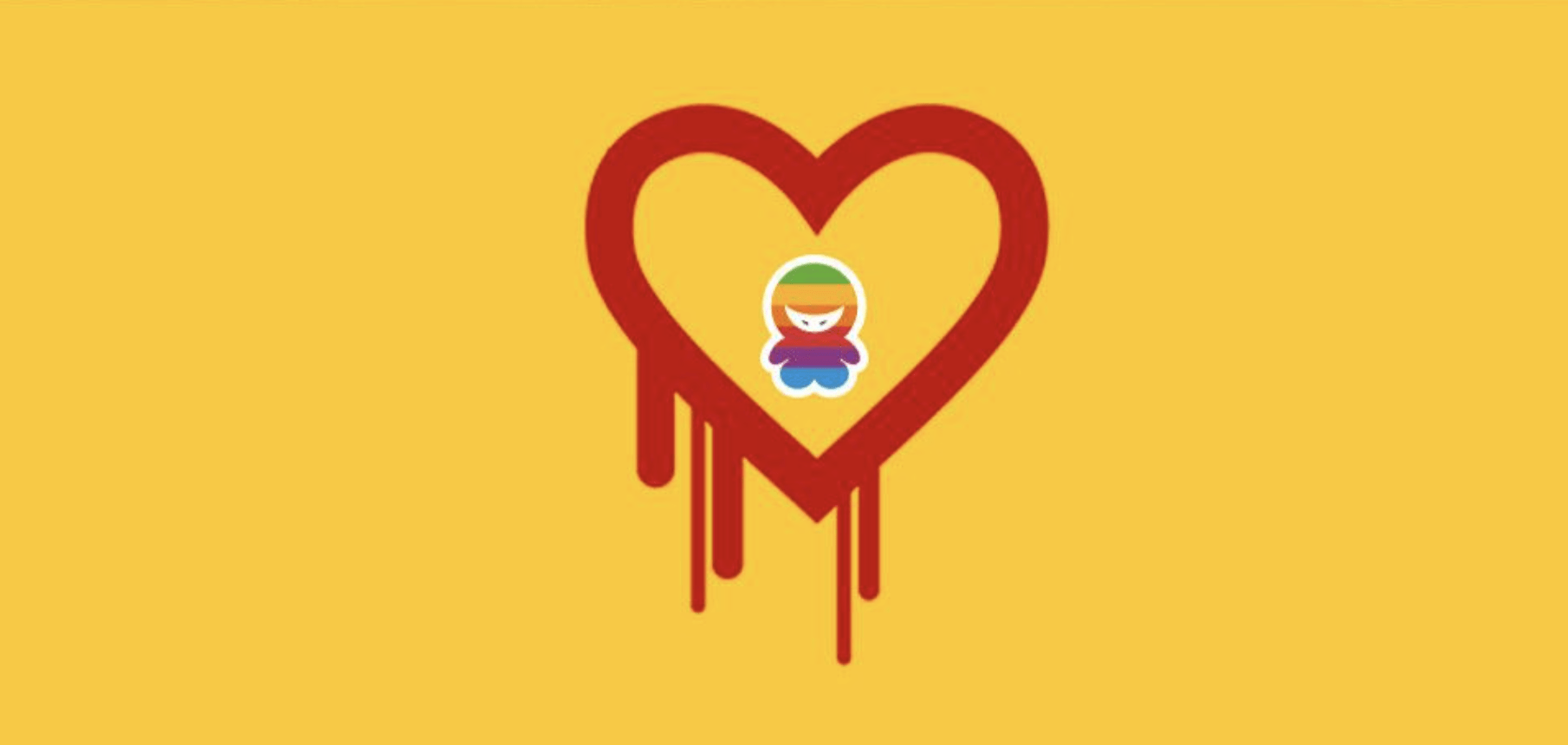
JadoPado acquisition was just announced. We loved the JadoPado platform, we kept following the amazing development and great designs created by a truly innovative team. We were excited about looking at hotcake. However, when we looked at the prices and the features they are stuffing to differentiate the various subscription plans. Local sellers don’t care about disk space, bandwidth, or the total number of listings. They want leads and they want to sell with the lowest overhead margin possible! The sad part of the story the marketplace was open one day and it just closed today without any prior warning to sellers. A lot of them may have depended solely on the platform to sell. Or it may just be that JadoPado is running for the cover because of Amazon's arrival to the Middle East retailer commerce market. They may have learned the lessons from what happened when Amazon entered the Indian Marketplace with the "Take No Prisoners" attitude in dealing with competitors.

Yes. if you are leaving your lucrative job to make more money, then don’t leave. Especially in the first 2-3 years or maybe more if you are aggressively focusing on growth. When we were doing the business plan for LeadCenter.AI and Storat.com and calculating risks and odds, we have decided to pursue something we truly care about more than money. That is a vision to web-enable small and micro-businesses in the middle east and bringing advanced automation to them. We have decided to pursue that vision although we know the risk ahead with 99% historical failure rate for our flagship product because of the difficulty of establishing the network effect. However, it is that vision that is fueling our engine and giving us unlimited energy to keep on with all the long hours, miss-steps, and difficulties.
Money is only a byproduct of doing something you are truly passionate about.
You should face the reality before you even start. A startup is a business with a shortage of money, no brand, no product, no customers, no trust, no offices, no legal structure, and no employees. You will be confused about your vision and uncertain about your success. You should build all of that along with 1 or 2 co-founders. The volume of work for the first few years means you need to get accustomed to 12-18 hours work shift per day, including weekends every single day for the first few years. You will need to depart from a lot of things you love and care about. You will need an obscene amount of support from your family and closest friends.
“The most impressive people I know spent their time with their head down getting things done for a long, long time. ” - Sam Altman
This will come naturally to most entrepreneurs. Since I started my company I discovered the most important asset in the world is not money, capability, or reach, it is TIME. It will come naturally to you to wake up at 4 or 5 AM every day. The days I wake up after 6:00 AM, It feels like I have lost the initiative for that day!
In the corporate world, we are accustomed to making excuses or complaining about why things are not working. It becomes part of the process with business justification sheets and endless business reviews. When you launch your own business, there is nobody to complain to or make excuses about why things are not working. You are on your own! You must make decisions faster, recover as fast as possible from mistakes or wrong decisions. While you don’t have to spend, endless time building justification for others, you will need an obscene amount of openness with yourself to learn and recover quickly. The simplicity formula we found to correct our path is to stay close and always listen to our customers.
If you care much about your ego, don’t start a business. The ego that will stop you from walking the streets selling your business or cold calling hundreds of customers every day to close no deals or 1-2 deals at best. The ego that will make you afraid of embarrassment, admitting mistakes, or correcting your course quickly. The ego that will stop from listening to customers need because you are fascinated with your product. Unlike established corporate businesses where ego issues can harm, in a startup, Ego is a killer!
You will need to control your fears, mostly is the fear of failure. Fear is a very obsessive force that can cripple humans and society. Focus on the hope, the journey, and the learning. Success is only an accumulation of all your failures.
"What would life be if we had no courage to attempt anything?" Vincent van Gogh
Tomorrow is formally my last day working for Microsoft Corporation so I can dedicate my time and energy to storat.com. In respect of a great company that I worked for more than 19 years, I am proud to share part of my last email to my colleagues.
"Hello All;
I have decided to leave Microsoft to focus on a software startup company that I started a few months back.
When people ask me what is the most amazing thing about Microsoft that kept you all those years, I tell them it is in an HR code that few people, even in Microsoft, might know or remember. The code is “Attract, Develop, Keep”. The most amazing thing about this company is its PEOPLE where Microsoft continues to do a great job in attracting, developing, and keeping great people.
I walked into this company 19 years ago with no skills, but a great passion for technology. I couldn’t have imagined where Microsoft would take me. Providing me generous training and career opportunities to develop locally and overseas across four continents, including sponsoring my MBA. Giving me the space to make mistakes and learn from those mistakes, which was priceless to learn and develop.

So from the bottom of my heart THANK YOU so much: my team, my colleges and partners in the Middle East & Africa, Saudi, Gulf, US Gulf Coast District, Corp and all the PEOPLE of Microsoft who taught me and helped me fulfill so many of my dreams. It is really hard to leave such a great company and great people, but it is a passion for entrepreneurship that I need to fulfill.
My startup inherits most of its values, people's philosophy, and vision for a better world from what I learned from many of you over the years in Microsoft.
leadcenter.ai is trying to address a challenging market where 99% of small and micro-businesses in the middle east are not web-enabled, don’t have a business email or a website, have limited access to automation and technology. Small businesses want to make use of modern technology to reach more customers and achieve accelerated growth. While small businesses are fueling the growth of advanced economies in the United States, Europe, and Asia, They represent a small percentage of middle east economies' GDP. Information technology and cloud services represent a unique opportunity for small businesses in the middle east to expand presence, reach more customers, and accelerate their growth using cloud services at a fraction of what it used to cost only 5 years ago.
I have assembled a great and passionate team that is in the process of building a state of the art marketplace that hopes to address some of those challenges. The marketplace will help small businesses build online stores, advertise about their products, share their news and deals and ultimately host their online websites and eCommerce stores on leadcenter.ai with a cluster of other services for free or at a fraction of the cost using simple and intuitive applications hosted on leadcenter.ai
We have just launched the marketplace first version, exclusive for now to UAE residents. We have received very positive feedback from literally hundreds of users with recommendations and requests. The website already has thousands of users registered and jumped in popularity in the United Arab Emirates from site 40,000 to site 1,240 most popular website in UAE in less than 25 days. We are looking forward to launching the portal in full production in early October and start reaching out to small businesses to help them with web-enablement. Please feel free to follow this blog to receive regular updates about our progress.